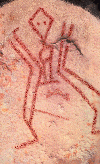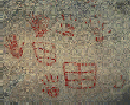ROCK ART IN URUGUAY
In 1874, four years before the discovery of Altamira paintings in Europe (which were not considered as prehistoric art initially), a Spanish engineer in Uruguay,
 Barrial Posadas, copied meticulously the designs he saw in an enormous rock, adding later a footprint stating that, undoubtedly, they were "Indian designs".
Barrial Posadas, copied meticulously the designs he saw in an enormous rock, adding later a footprint stating that, undoubtedly, they were "Indian designs".
This occurred in a country like Uruguay, where they boasted across America, ever since last century, about no longer having Indians.
After that first contribution (that marks the birth of the first stage of Uruguayan archeology), other researchers such as Figuerido, Larrauri, De Freitas, Consens and Bespali, Pelaez and Consens have worked, publishing, checking and discovering new sites on the rest of the country.
As a result of such investigations, today we know as close as ten sites with paintings and engravings. The firsts located to the south of the Negro river, and the latters to the north.
ENGRAVINGS
They started about 6 to 8 thousand years before present in an environment very different to the one we can see today. For that reason, we can see
 how "guanacos" (extincted today) and felines appear in big horizontal blocks, next to simple geometrical drawings. Thousands of years later, in the same areas, intrincated maze like figures appear next to marks of parallel lines and grouped points.
how "guanacos" (extincted today) and felines appear in big horizontal blocks, next to simple geometrical drawings. Thousands of years later, in the same areas, intrincated maze like figures appear next to marks of parallel lines and grouped points.

Engravings appeared once more about two thousand years ago. Then, designs become more complex due to the reutilization not only of the sites, but also of the same blocks used before. This forced researchers to undergo complex technical works to recover information.
And finally, about one thousand two hundred years ago, a style emerges showing schematic designs, anthropomorphic as well as zoomorphic, along an engraving technic with profound designs and internal smooth surfaces. Some of those sites received ritual offerings.
PAINTINGS
They are performed on enormous vertical walls of granite blocks, emerging as big monuments on the ample and undulated prairies of southern Uruguay.

Nowadays, about forty of these sites are preserved with an acceptable degree of visual perception. Meanwhile, on near a hundred blocks we can barely see remains of what once were important mural paintings. Some areas of the provinces of Flores, Florida and Durazno must have been by that time true outdoor exhibits.
Painting began at least about two thousand five hundred years before present. There was a later period, around the year 1200 AD, where paintings are performed on the same stylistic basis of geometrical figures, but now complex closed forms are used showing an important variation on internal designs.
During that period as well, several different technics are tested such as the use of fine brushes (2 to 3 mms.), the preparation of the surface before performing the designs, hands in positive and even paintings in negative. There is a special care about avoiding superimposing paintings, putting special attention on the use of space as a very valuable reference.
ACTUAL STATE
Damages due to vandalism and an incorrect application of the mining law (which demanded 13  years of formal complaints, even those published on the press, to get it modified) provoked the disappearance of about 20% of the Uruguayan rock art. Another 30% of the sites show extremely serious damage on the surfaces and on the designs themselves. All these damage took place during the last 20 years.
years of formal complaints, even those published on the press, to get it modified) provoked the disappearance of about 20% of the Uruguayan rock art. Another 30% of the sites show extremely serious damage on the surfaces and on the designs themselves. All these damage took place during the last 20 years.
Works on documentation of the rock art sites in Uruguay have been undertaken in the last 20 years with the technical, human, infrastructure and economical support of CIARU, with its non governmental organization position.
Despite of the repeated requests for economic aid presented to the Ministry of Education and Culture along these years, it was never possible to count on any kind of support, not even to protect the sites.
In this sense, the Town Council of Flores has made important as well as valuable efforts to protect the sites located on its area (look for this information on another page of this web site).
CIARU keeps digitalized records about all paintings and engravings it documented in the last 25 years of work in Uruguay, even on several of them that have already disappeared. During the last years, CIARU has carried out public exhibits, conferences as well as distributing bibliographic material in order to sensitize and make known the prehistoric art of the country.